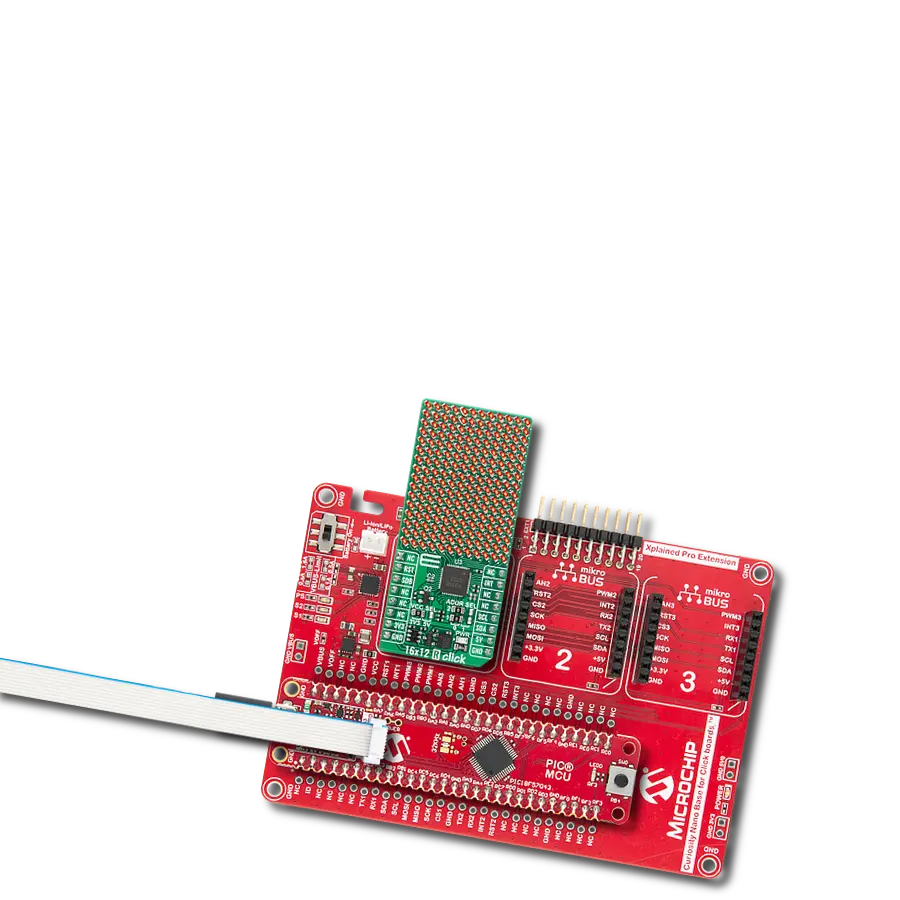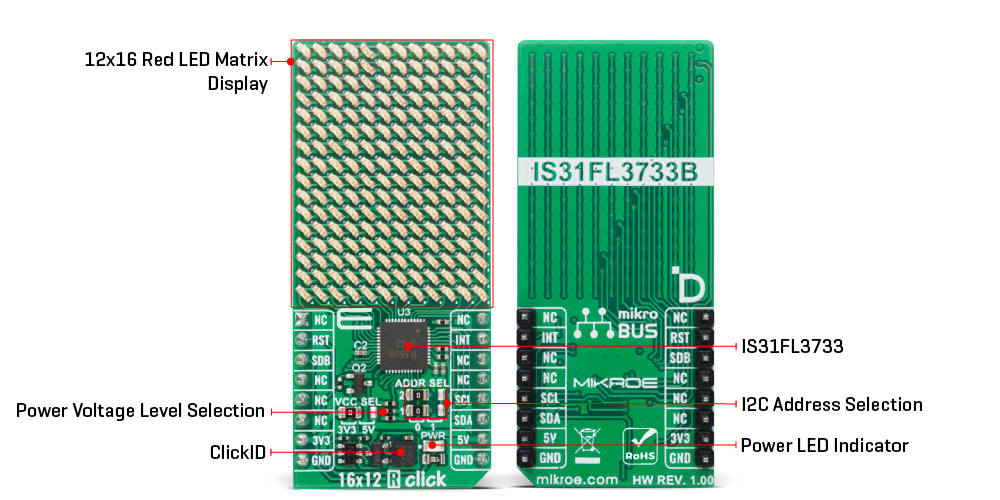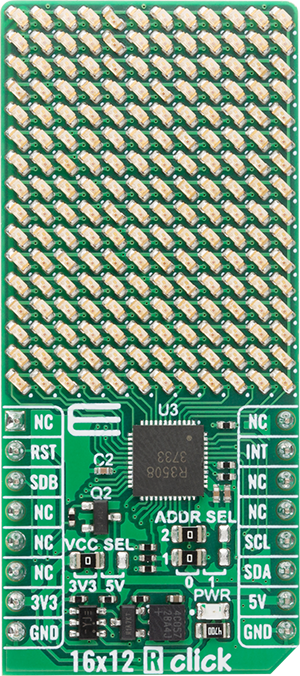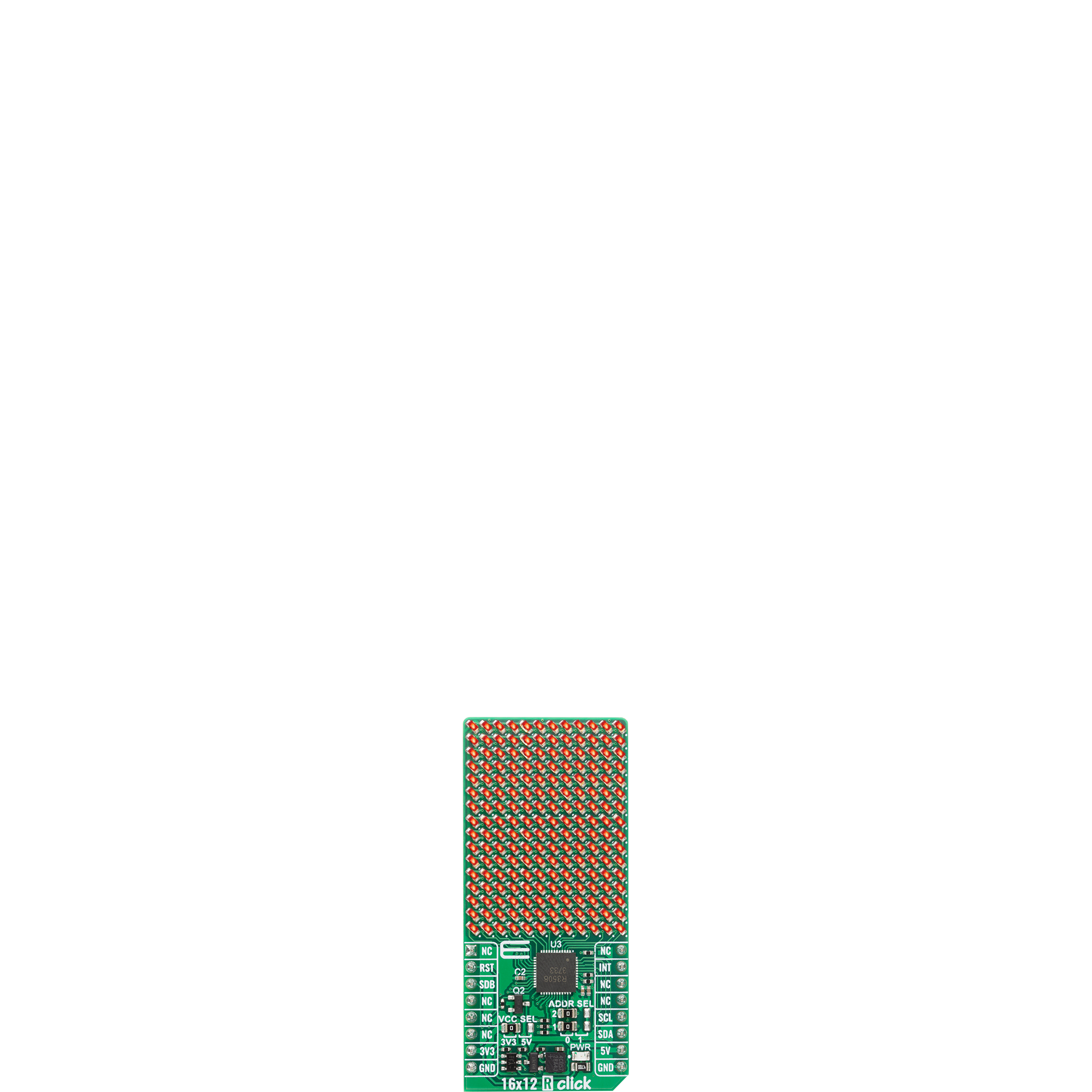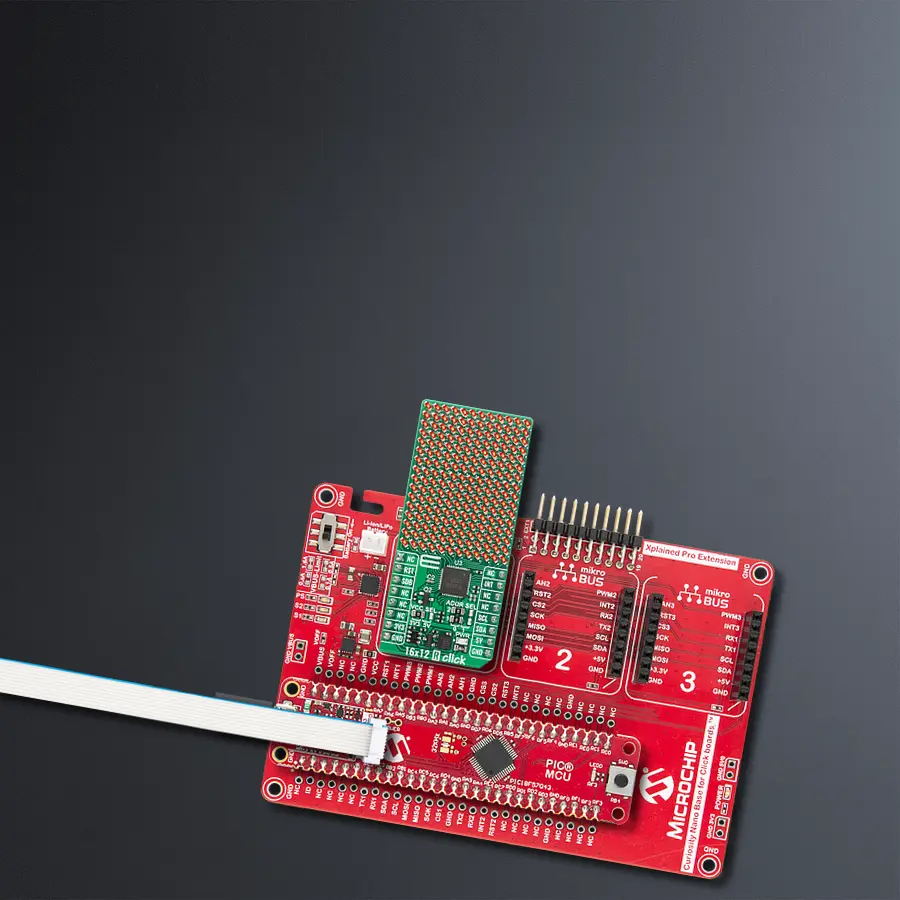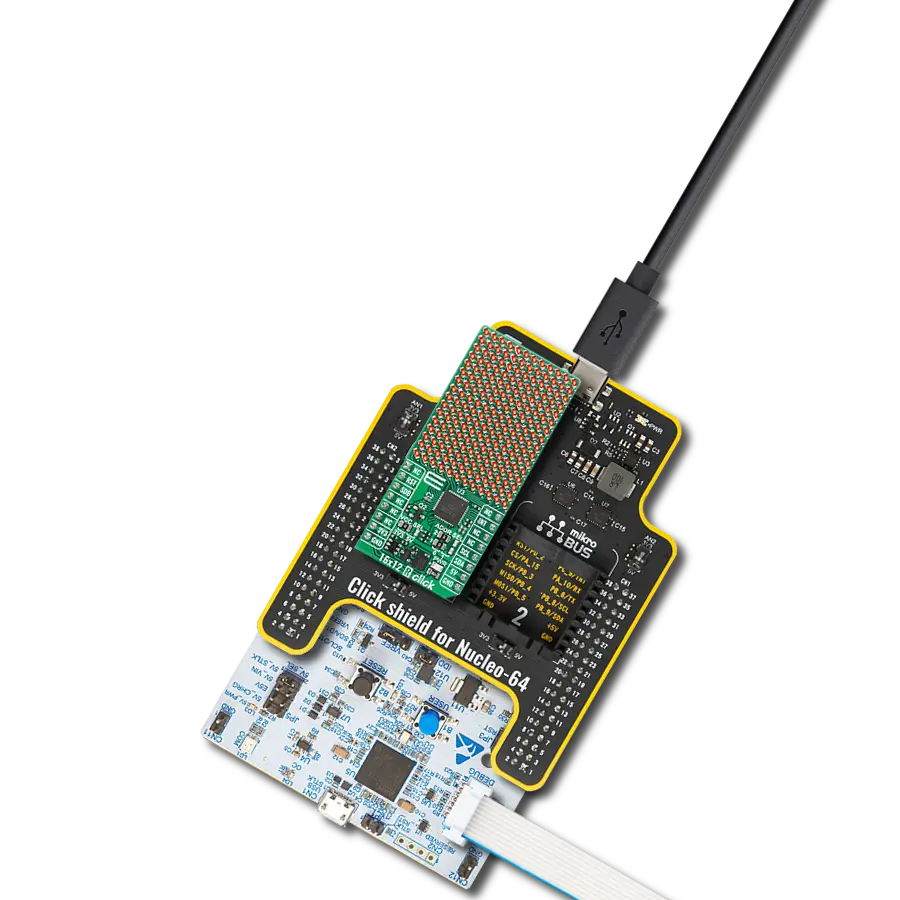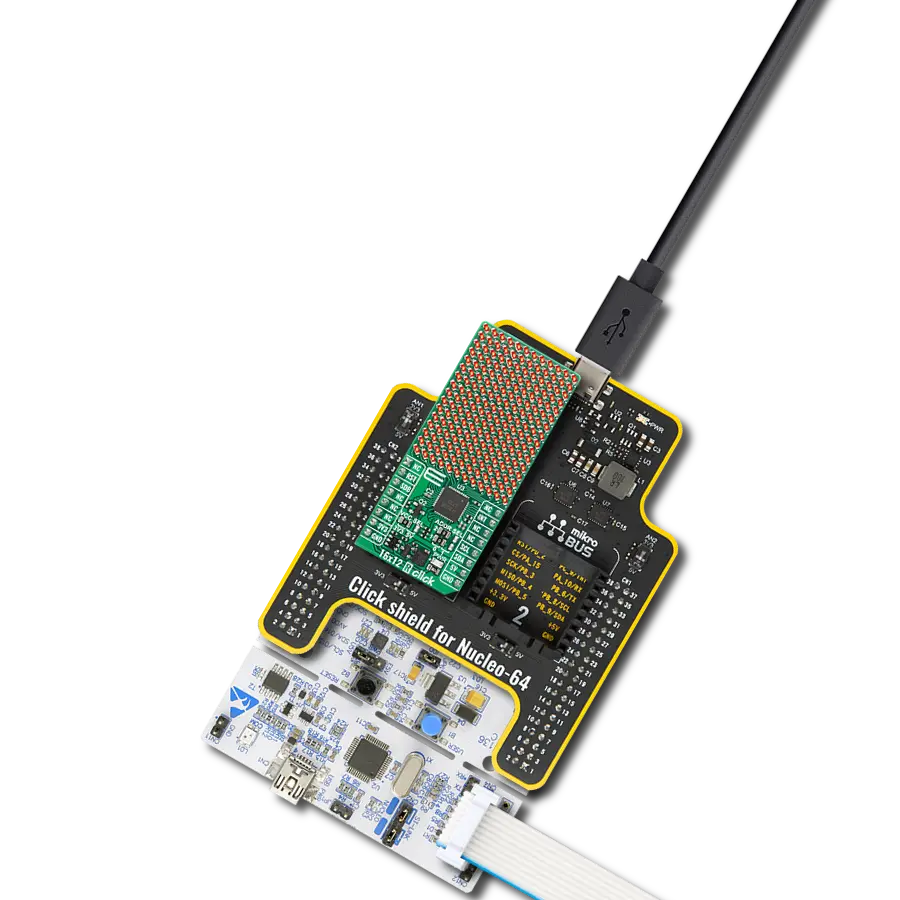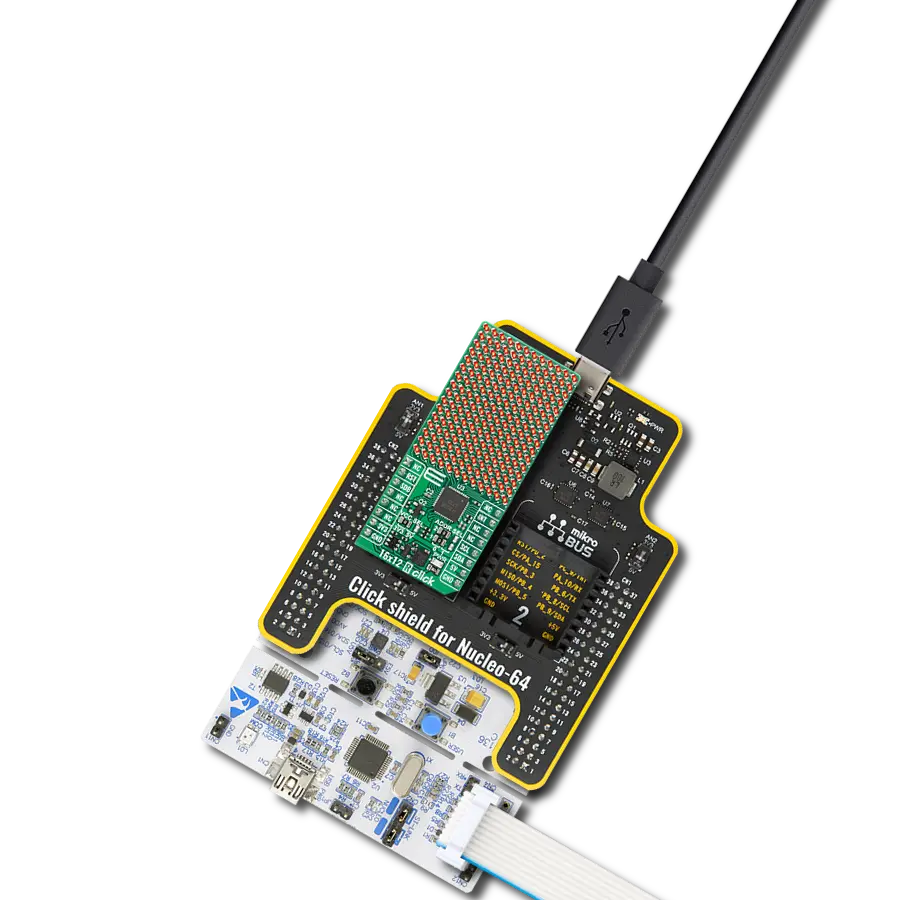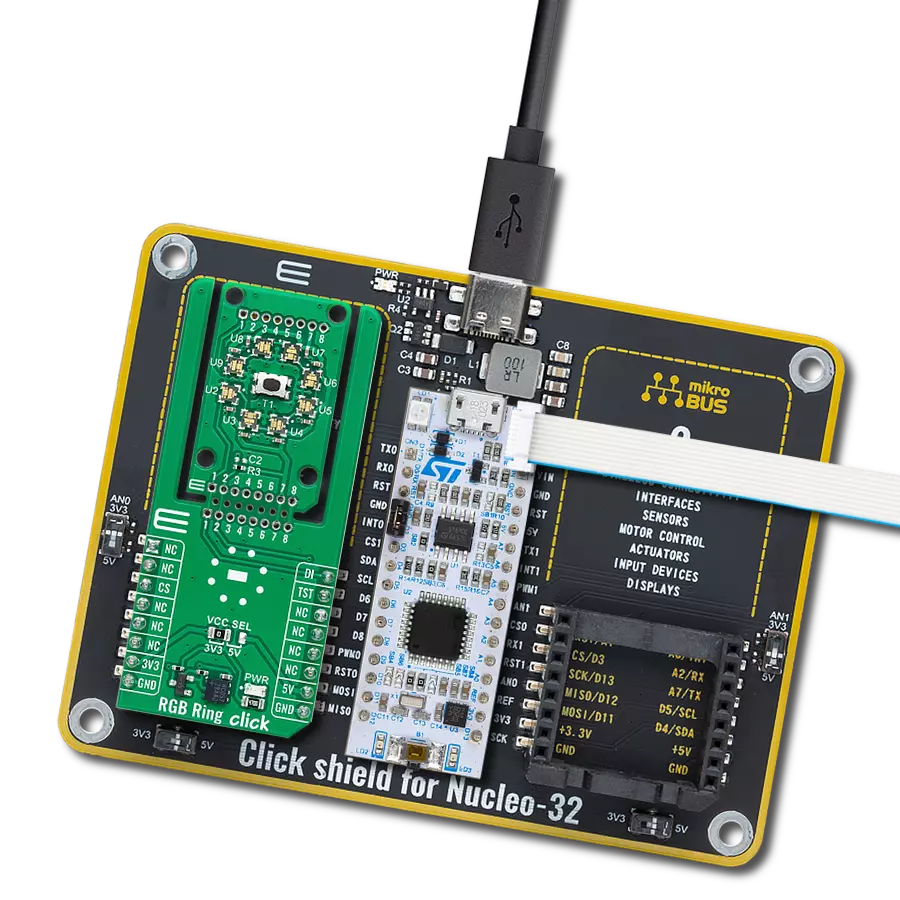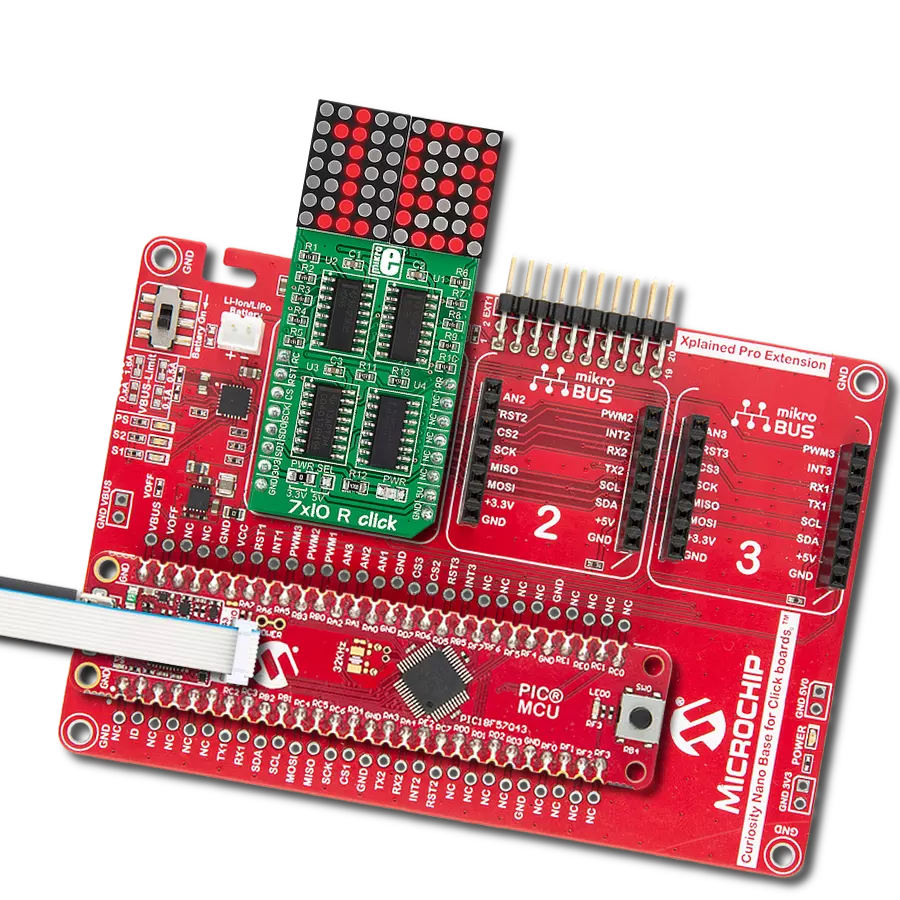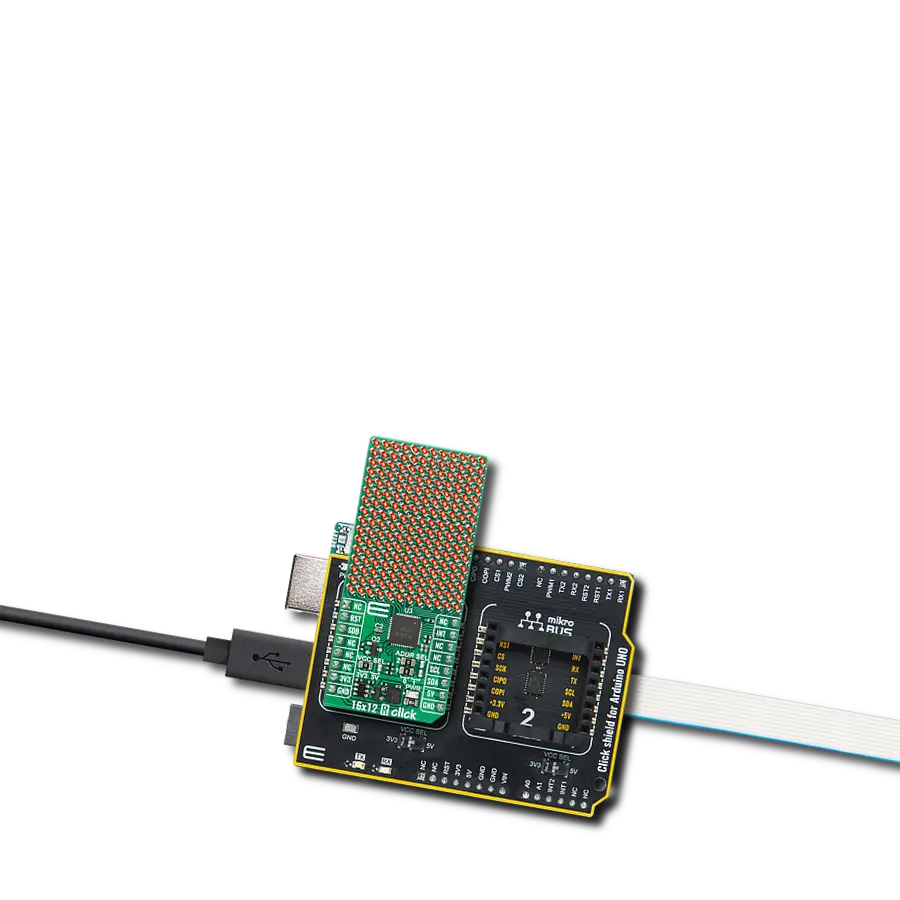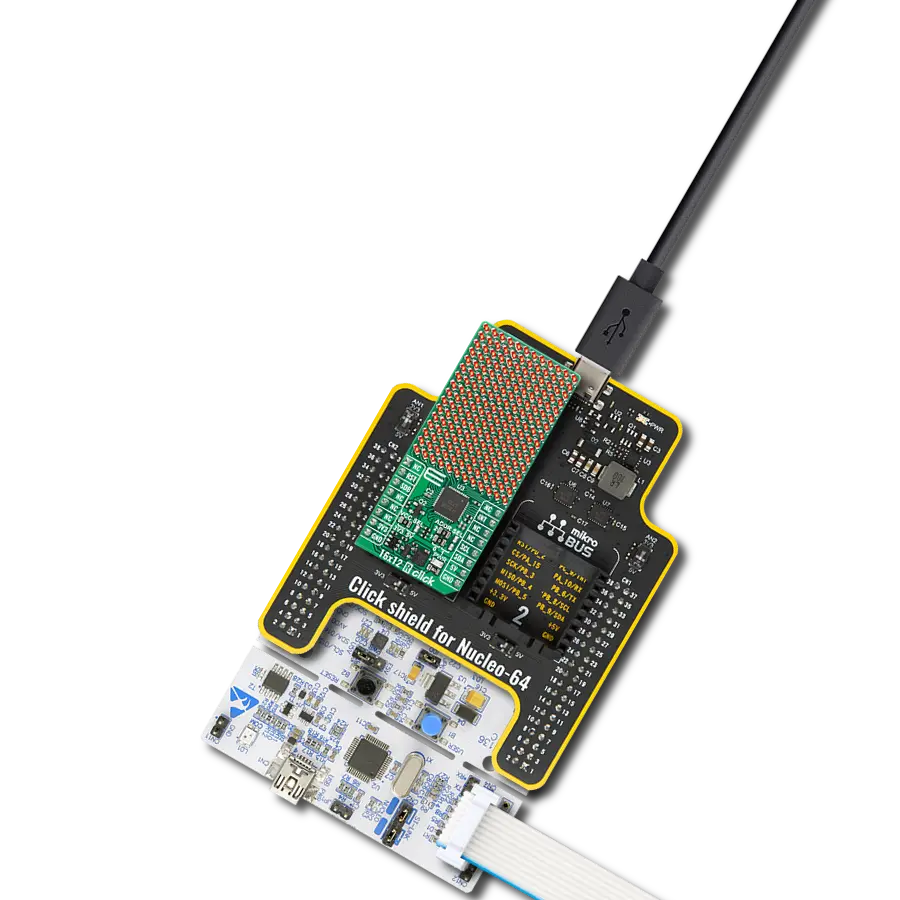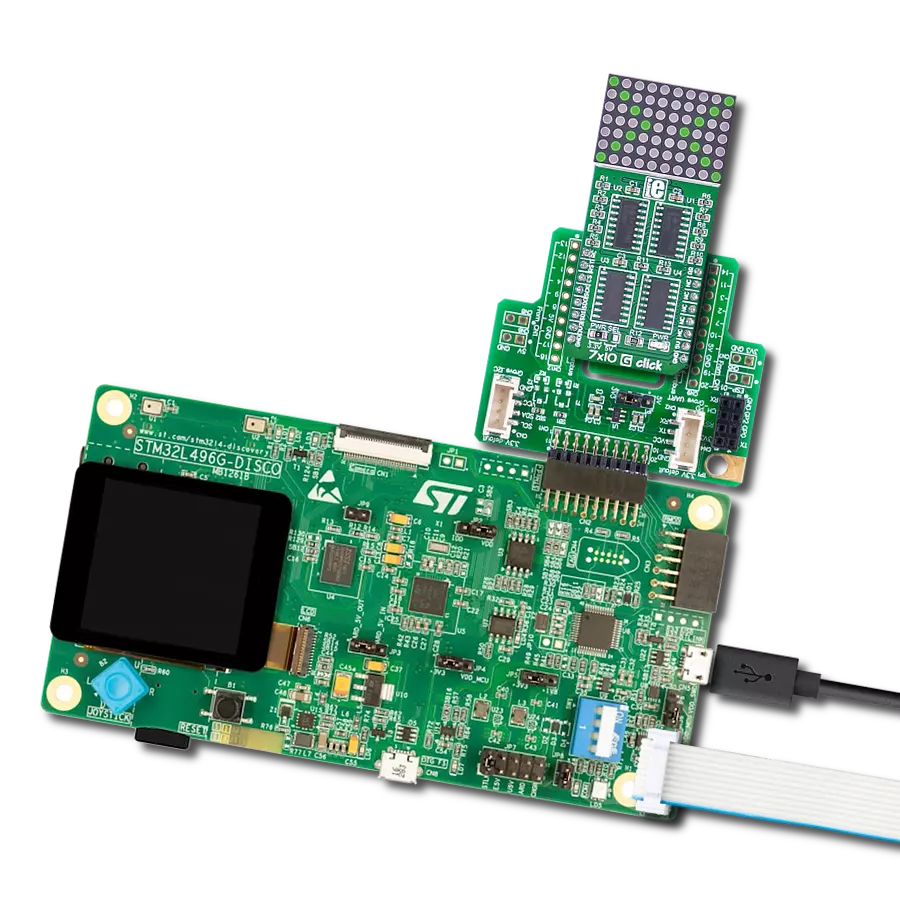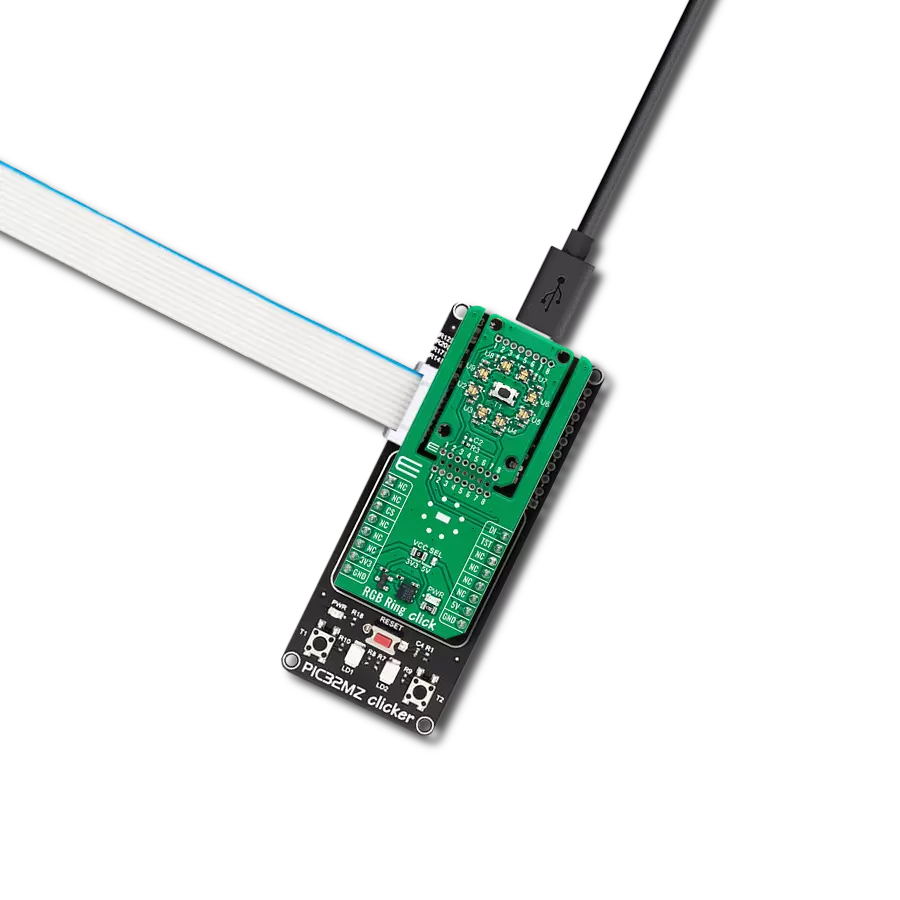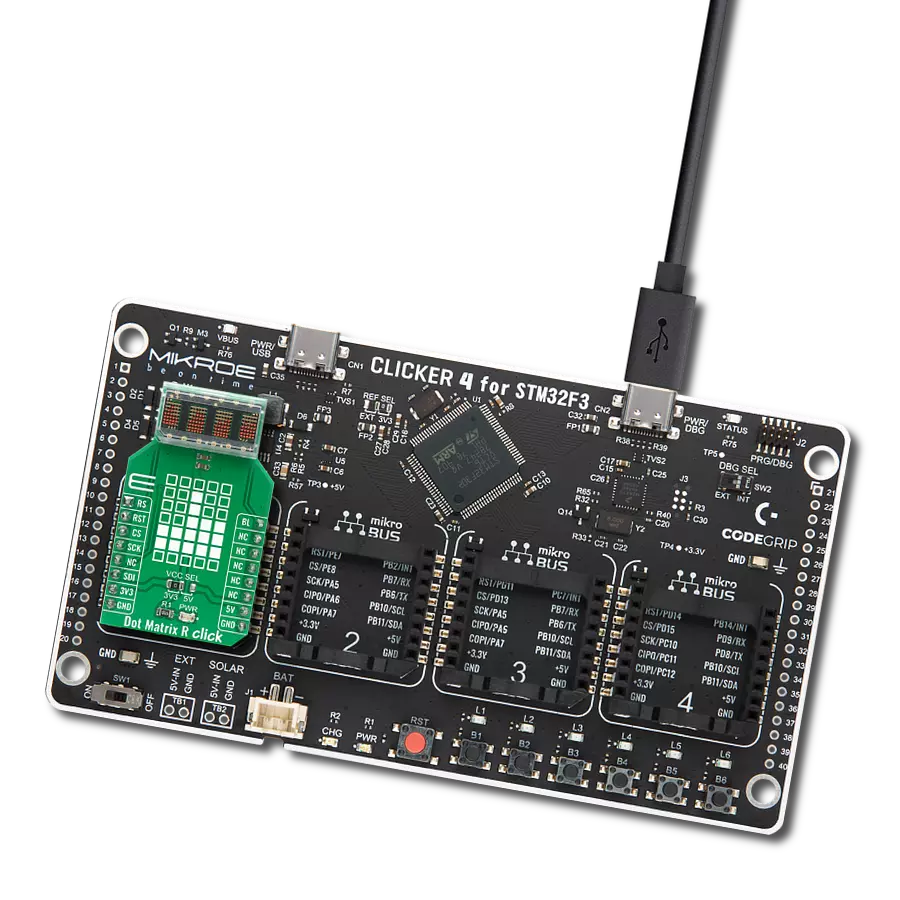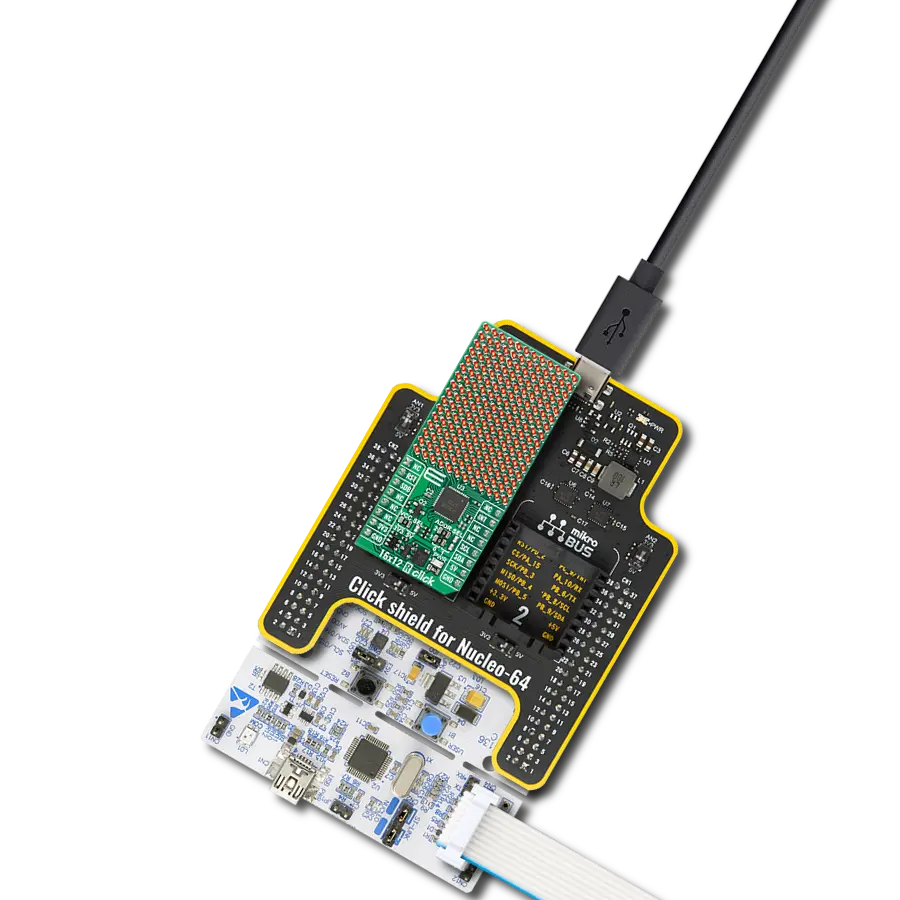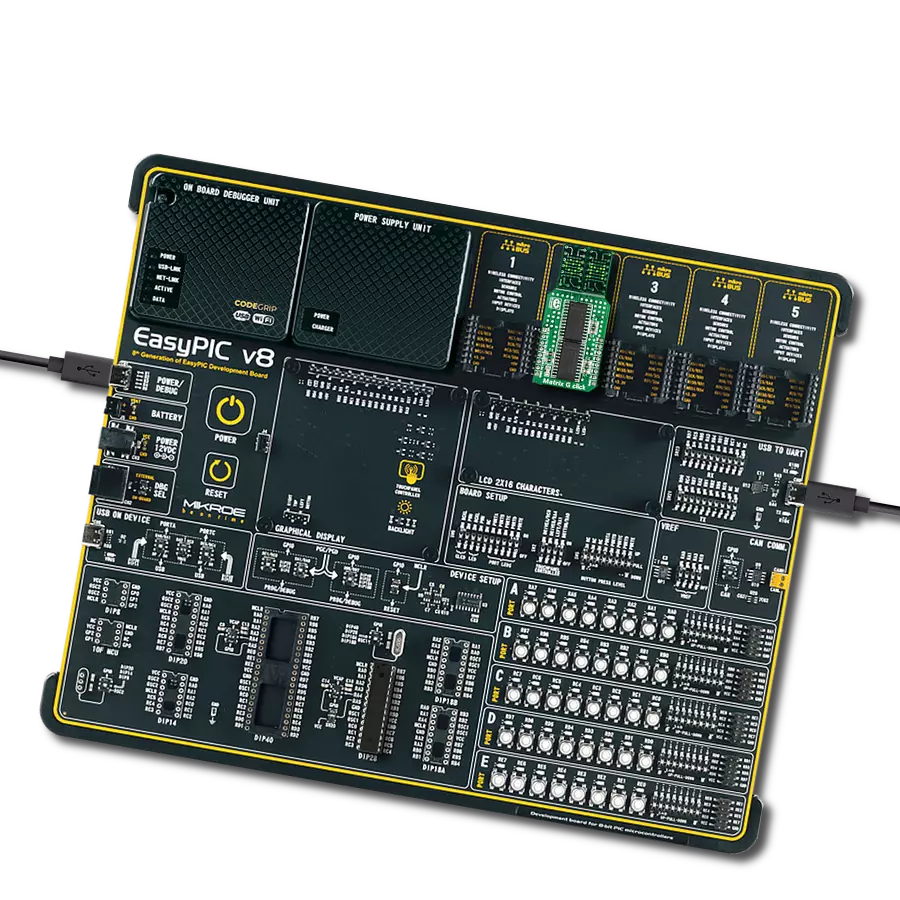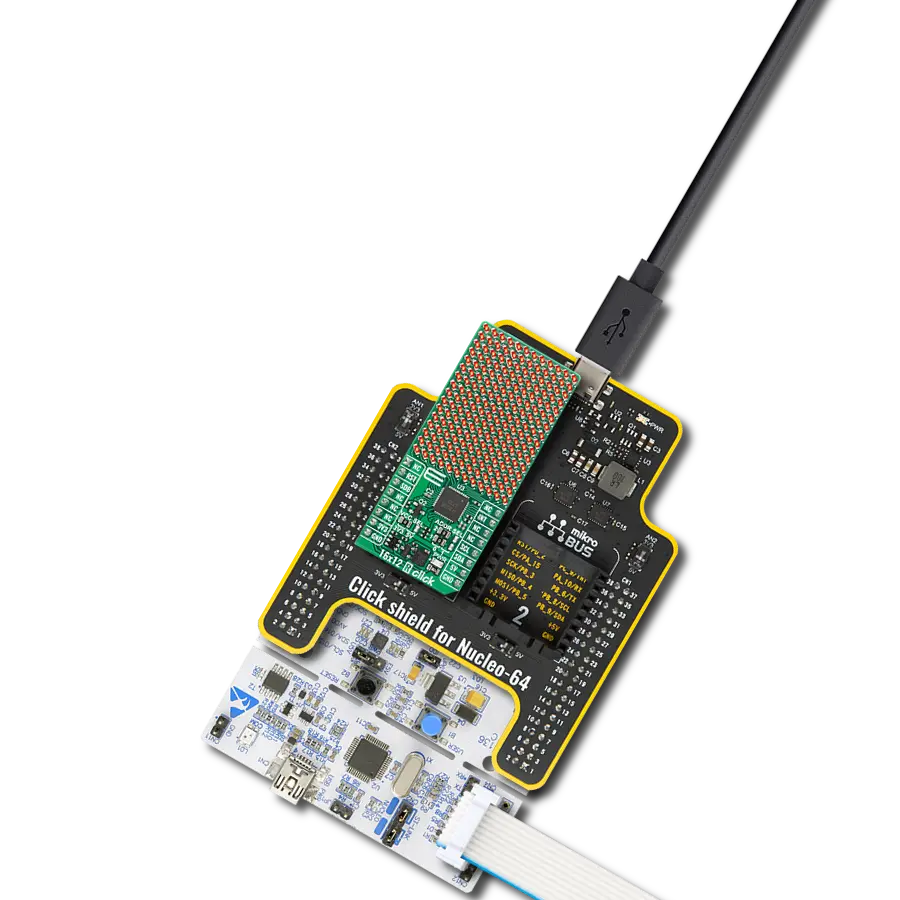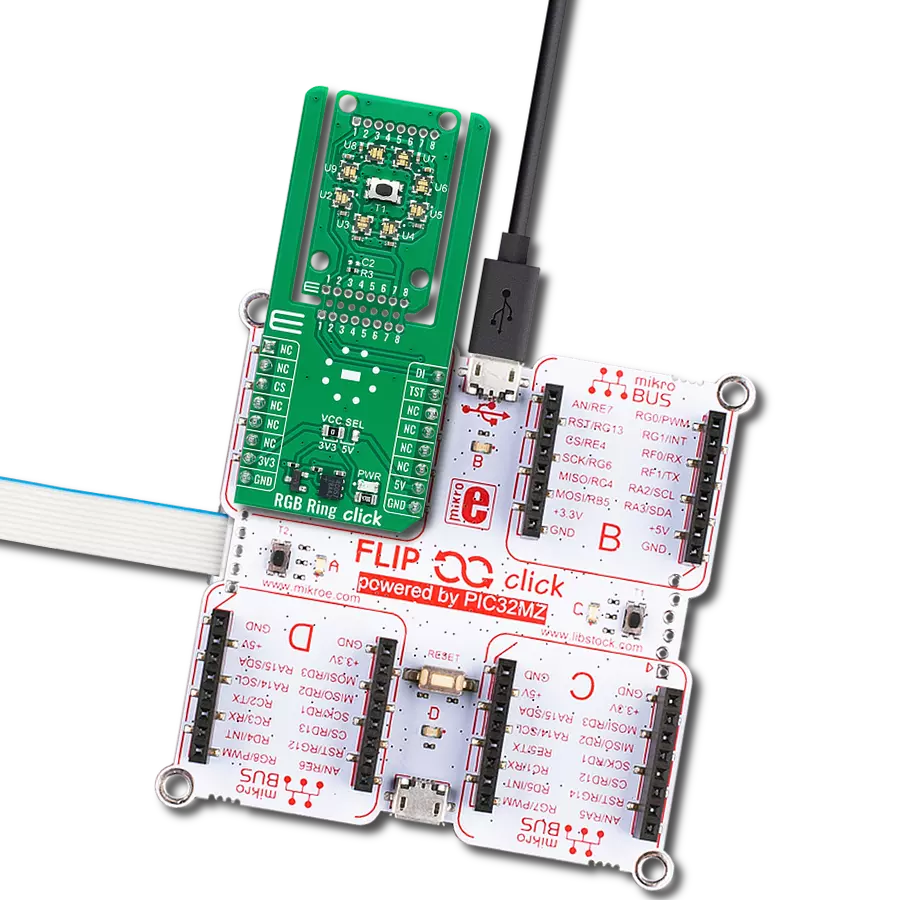Go-to solution for any application requiring precise and versatile red LED matrix management
A
A
Hardware Overview
How does it work?
16x12 R Click is based on the IS31FL3733 matrix driver from ISSI, a general-purpose 12×16 LEDs driver with a 1/12 cycle rate. This board integrates a 16x12 red LED display and allows full control of each LED for ON/OFF switching and brightness adjustment, making it an ideal solution for creating advanced visual indicators, status displays, and animation effects. Each of the 192 LEDs can be dimmed individually with 8-bit PWM data, providing 256 steps of linear dimming resolution for precise brightness control. Communication with the host MCU is achieved through the standard I2C 2-Wire interface, supporting Standard-Mode (100 kHz),
Fast-Mode (400 kHz), and Fast-Mode Plus (1 MHz) operation, ensuring compatibility and flexibility across a wide range of applications. The user can configure the I2C address via onboard SMD jumpers labeled ADDR SEL, which set the last three LSBs of the I2C address, allowing multiple devices to coexist on the same bus. In addition to the I2C communication pins, the IS31FL3733 also uses an INT pin for interrupt signaling, RST pin for chip reset, and an SDB pin for shutdown control, further enhancing functionality and power management. With its ability to manage large LED arrays, 16x12 R Click is suitable for applications
such as information panels, event counters, gaming devices, audio spectrum displays, notification systems, and other embedded solutions requiring detailed LED matrix control. This Click board™ can operate with either 3.3V or 5V logic voltage levels selected via the VCC SEL jumper. This way, both 3.3V and 5V capable MCUs can use the communication lines properly. Also, this Click board™ comes equipped with a library containing easy-to-use functions and an example code that can be used as a reference for further development.
Features overview
Development board
PIC18F57Q43 Curiosity Nano evaluation kit is a cutting-edge hardware platform designed to evaluate microcontrollers within the PIC18-Q43 family. Central to its design is the inclusion of the powerful PIC18F57Q43 microcontroller (MCU), offering advanced functionalities and robust performance. Key features of this evaluation kit include a yellow user LED and a responsive
mechanical user switch, providing seamless interaction and testing. The provision for a 32.768kHz crystal footprint ensures precision timing capabilities. With an onboard debugger boasting a green power and status LED, programming and debugging become intuitive and efficient. Further enhancing its utility is the Virtual serial port (CDC) and a debug GPIO channel (DGI
GPIO), offering extensive connectivity options. Powered via USB, this kit boasts an adjustable target voltage feature facilitated by the MIC5353 LDO regulator, ensuring stable operation with an output voltage ranging from 1.8V to 5.1V, with a maximum output current of 500mA, subject to ambient temperature and voltage constraints.
Microcontroller Overview
MCU Card / MCU

Architecture
PIC
MCU Memory (KB)
128
Silicon Vendor
Microchip
Pin count
48
RAM (Bytes)
8196
You complete me!
Accessories
Curiosity Nano Base for Click boards is a versatile hardware extension platform created to streamline the integration between Curiosity Nano kits and extension boards, tailored explicitly for the mikroBUS™-standardized Click boards and Xplained Pro extension boards. This innovative base board (shield) offers seamless connectivity and expansion possibilities, simplifying experimentation and development. Key features include USB power compatibility from the Curiosity Nano kit, alongside an alternative external power input option for enhanced flexibility. The onboard Li-Ion/LiPo charger and management circuit ensure smooth operation for battery-powered applications, simplifying usage and management. Moreover, the base incorporates a fixed 3.3V PSU dedicated to target and mikroBUS™ power rails, alongside a fixed 5.0V boost converter catering to 5V power rails of mikroBUS™ sockets, providing stable power delivery for various connected devices.
Used MCU Pins
mikroBUS™ mapper
Take a closer look
Click board™ Schematic
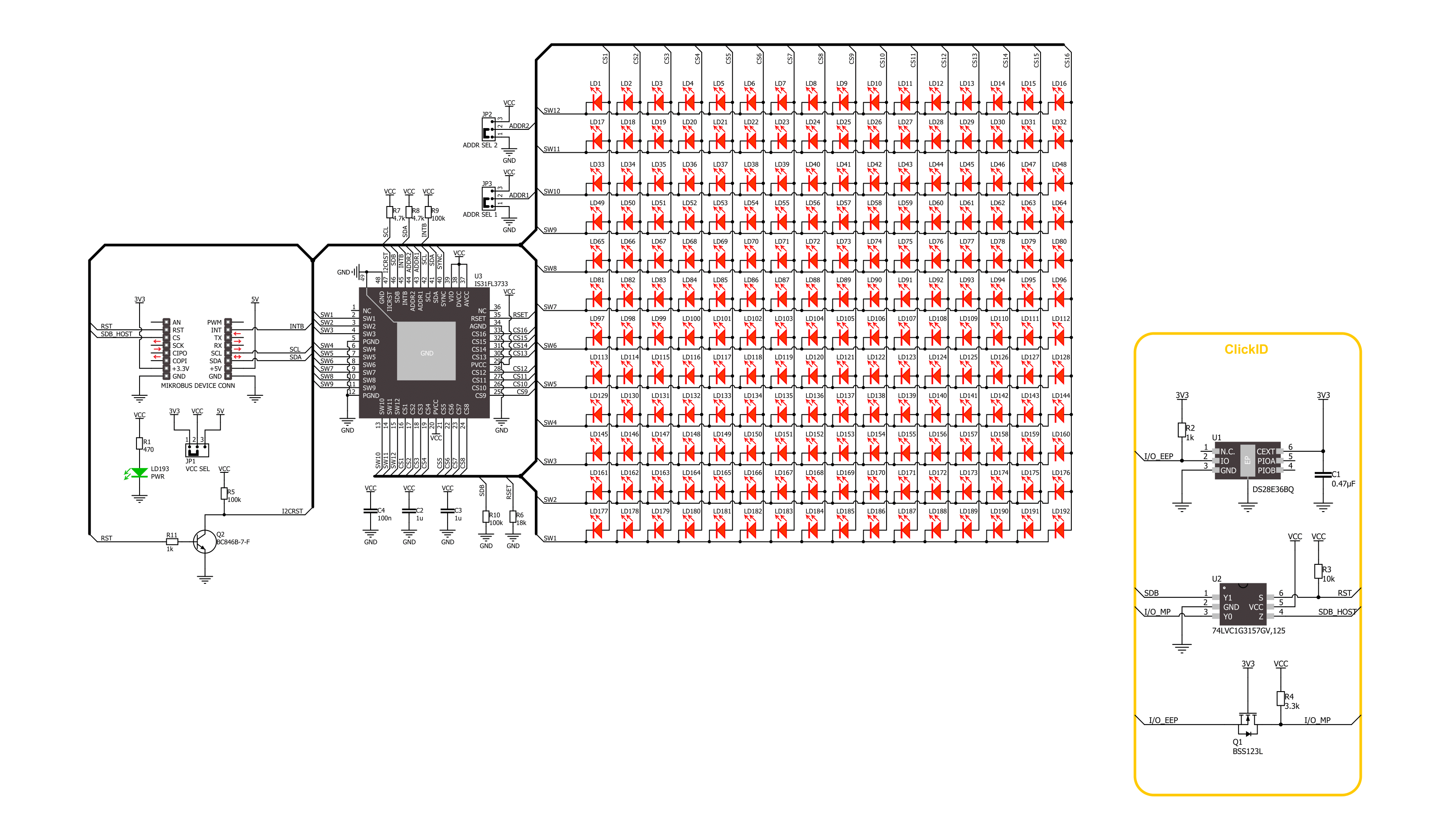
Step by step
Project assembly
Software Support
Library Description
16x12 R Click demo application is developed using the NECTO Studio, ensuring compatibility with mikroSDK's open-source libraries and tools. Designed for plug-and-play implementation and testing, the demo is fully compatible with all development, starter, and mikromedia boards featuring a mikroBUS™ socket.
Example Description
This example demonstrates the usage of the 16x12 R Click board which features a high-brightness red LED matrix display. It displays characters, rotates them in different orientations, prints a scrolling string, and renders a graphical image (MIKROE logo).
Key functions:
c16x12r_cfg_setup- This function initializes Click configuration structure to initial values.c16x12r_init- This function initializes all necessary pins and peripherals used for this Click board.c16x12r_default_cfg- This function executes a default configuration of 16x12 R Click board.c16x12r_write_char- This function writes a single ASCII character to the display.c16x12r_write_string- This function scrolls a null-terminated ASCII string across the display.c16x12r_draw_picture- This function draws a picture on the display from a 12-column buffer.
Application Init
Initializes the logger and the Click board and sets the default configuration.
Application Task
Displays single characters and a string in multiple rotations, followed by drawing and inverting the MIKROE logo image.
Open Source
Code example
The complete application code and a ready-to-use project are available through the NECTO Studio Package Manager for direct installation in the NECTO Studio. The application code can also be found on the MIKROE GitHub account.
/*!
* @file main.c
* @brief 16x12 R Click example
*
* # Description
* This example demonstrates the usage of the 16x12 R Click board which features a high-brightness
* red LED matrix display. It displays characters, rotates them in different orientations,
* prints a scrolling string, and renders a graphical image (MIKROE logo).
*
* The demo application is composed of two sections :
*
* ## Application Init
* Initializes the logger and the Click board and sets the default configuration.
*
* ## Application Task
* Displays single characters and a string in multiple rotations, followed by
* drawing and inverting the MIKROE logo image.
*
* @author Stefan Filipovic
*
*/
#include "board.h"
#include "log.h"
#include "c16x12r.h"
#include "c16x12r_resources.h"
static c16x12r_t c16x12r;
static log_t logger;
void application_init ( void )
{
log_cfg_t log_cfg; /**< Logger config object. */
c16x12r_cfg_t c16x12r_cfg; /**< Click config object. */
/**
* Logger initialization.
* Default baud rate: 115200
* Default log level: LOG_LEVEL_DEBUG
* @note If USB_UART_RX and USB_UART_TX
* are defined as HAL_PIN_NC, you will
* need to define them manually for log to work.
* See @b LOG_MAP_USB_UART macro definition for detailed explanation.
*/
LOG_MAP_USB_UART( log_cfg );
log_init( &logger, &log_cfg );
log_info( &logger, " Application Init " );
// Click initialization.
c16x12r_cfg_setup( &c16x12r_cfg );
C16X12R_MAP_MIKROBUS( c16x12r_cfg, MIKROBUS_1 );
if ( I2C_MASTER_ERROR == c16x12r_init( &c16x12r, &c16x12r_cfg ) )
{
log_error( &logger, " Communication init." );
for ( ; ; );
}
if ( C16X12R_ERROR == c16x12r_default_cfg ( &c16x12r ) )
{
log_error( &logger, " Default configuration." );
for ( ; ; );
}
log_info( &logger, " Application Task " );
}
void application_task ( void )
{
log_printf( &logger, " Writing digits\r\n\n" );
c16x12r.text_rotation = C16X12R_ROTATION_H_0;
for ( uint8_t digit = '0'; digit <= '9'; digit++ )
{
c16x12r_write_char ( &c16x12r, digit );
Delay_ms ( 500 );
}
log_printf( &logger, " Rotating char\r\n\n" );
c16x12r.text_rotation = C16X12R_ROTATION_H_0;
c16x12r_write_char ( &c16x12r, 'R' );
Delay_ms ( 500 );
c16x12r.text_rotation = C16X12R_ROTATION_H_180;
c16x12r_write_char ( &c16x12r, 'R' );
Delay_ms ( 500 );
c16x12r.text_rotation = C16X12R_ROTATION_V_0;
c16x12r_write_char ( &c16x12r, 'R' );
Delay_ms ( 500 );
c16x12r.text_rotation = C16X12R_ROTATION_V_180;
c16x12r_write_char ( &c16x12r, 'R' );
Delay_ms ( 500 );
c16x12r.text_rotation = C16X12R_ROTATION_H_0;
c16x12r_write_char ( &c16x12r, 'R' );
Delay_ms ( 500 );
log_printf( &logger, " Writing text\r\n\n" );
c16x12r.text_rotation = C16X12R_ROTATION_H_0;
c16x12r_write_string ( &c16x12r, "MIKROE - 16x12 R Click", 50 );
Delay_ms ( 1000 );
log_printf( &logger, " Writing text\r\n\n" );
c16x12r.text_rotation = C16X12R_ROTATION_H_180;
c16x12r_write_string ( &c16x12r, "MIKROE - 16x12 R Click", 50 );
Delay_ms ( 1000 );
log_printf( &logger, " Writing text\r\n\n" );
c16x12r.text_rotation = C16X12R_ROTATION_V_0;
c16x12r_write_string ( &c16x12r, "MIKROE - 16x12 R Click", 50 );
Delay_ms ( 1000 );
log_printf( &logger, " Writing text\r\n\n" );
c16x12r.text_rotation = C16X12R_ROTATION_V_180;
c16x12r_write_string ( &c16x12r, "MIKROE - 16x12 R Click", 50 );
Delay_ms ( 1000 );
log_printf( &logger, " Drawing MIKROE logo\r\n\n" );
c16x12r_draw_picture ( &c16x12r, c16x12r_img_mikroe );
Delay_ms ( 1000 );
Delay_ms ( 1000 );
log_printf( &logger, " Drawing inverted MIKROE logo\r\n\n" );
c16x12r_draw_picture ( &c16x12r, c16x12r_img_mikroe_inv );
Delay_ms ( 1000 );
Delay_ms ( 1000 );
}
int main ( void )
{
/* Do not remove this line or clock might not be set correctly. */
#ifdef PREINIT_SUPPORTED
preinit();
#endif
application_init( );
for ( ; ; )
{
application_task( );
}
return 0;
}
// ------------------------------------------------------------------------ END
Additional Support
Resources
Category:LED Matrix
